Monday, July 29, 2019
Printer Friendly Version in PDF Format (30 PDF pages)
The Road Map for Indian Country
Starting Conversations about Dementia in Indian Country: A Public Health Road Map
Bridging the GAP
Public Health/CDC bridges the gap between Biomedical Research and Community Services
What is the Public Health Approach?
- One at a time
- Many at a time
"Public Health" Strategies
- Work across a community for the health/well-being of populations
- All ages, stages of life
- Upstream: improve health & prevent disease, disability
Speakers
- Blythe Winchester, MD, MPH, CMD
- Certified Medical Director, Tsali Care Center Geriatrician, Cherokee Indian Hospital Chief Clinical Consultant, Geriatrics and Palliative Care, Indian Health Service
- Molly French
- Director of Public Health, Alzheimer's Association
- Carolyn Angus-Hornbuckle
- Director of Public Health Policy and Programs, National Indian Health Board
- Bruce Finke, MD
- Elder Health Consultant, Indian Health Service, Indian Health Services
- Lisa McGuire, PhD
- Lead, Alzheimer's Disease and Healthy Aging Program, Centers for Disease Control and Prevention
National Alzheimer's Project Act
Blythe Winchester, MD, MPH, CMD
Eastern Band Cherokee
Geriatrician, Cherokee Indian Hospital
Certified Medical Director, Tsali Care Center
Chief Clinical Consultant, Geriatrics and Palliative Care, Indian Health Service
Objectives
- Provide a brief snapshot of Indian Country with a focus on diversity, culture, and traditions
- Overview of dementia and caregiving in Indian Country
- Examples/case studies from my clinical experience to illustrate the issue in Indian Country
AIAN Elders
- The non-Hispanic American Indian and Native Alaskan older population was 231,482 in 2014, and is projected to grow to more than 630,000 by 2060
- Almost twice as many AI/ANs ages 50 and over are uninsured as are people of the same age in the US population
- Close to 22 percent of AI/ANs ages 50 and over receive care from the Indian Health Service (IHS)
- American Indians and Alaska Natives born today have a life expectancy that is 5.5 years less than the U.S. all races population (73.0 years to 78.5 years, respectively).
IHS updated April 2018 https://www.ihs.gov/newsroom/factsheets/disparities/
ACL https://acl.gov/aging-and-disability-in-america/data-and-research/minority-aging
Demographics/Epidemiology
- 5.2 million US residents AIAN, another 527,077 Native Hawaiian
- 2010- US Census estimated 37.1% AIAN and 26.7 % NHOPI (Native Hawaiians and other Pacific Islanders) were living alone
- 22% AIAN and NHPOI reported depressed mood much of the time in past year compared to 11.7% white elders
- Lower levels of cancer screening, esp for colorectal cancer
- 2010 data: 49.5% AIAN were in compliance with colorectal cancer screening recs compared to 59.8% whites. 55.8% Native Hawaiians compared to 64.2%
US census bureau https://www.census.gov/
Patrick M. Lynch, Colorectal cancer screening in the American Indian/Alaska Native population: Progress and at least one new challenge, Cancer, 120, 20, (3105-3107), (2014)
- AI/ANs have the highest prevalence of CVD of any racial or ethnic group
- AI/ANs experience high rates of disability, especially compared to Whites
- Heart disease, cancer, unintentional injuries, and diabetes are leading causes of American Indian and Alaska Native deaths (2009-2011)
- 22 percent of American Indians and Alaska Natives live on reservations or other trust lands. 60 percent of American Indians and Alaska Natives live in metropolitan areas
R. Turner Goins, Margaret Moss, Dedra Buchwald, Jack M. Guralnik; Disability Among Older American Indians and Alaska Natives: An Analysis of the 2000 Census Public Use Microdata Sample, The Gerontologist, Volume 47, Issue 5, 1 October 2007, Pages 690-696, https://doi.org/10.1093/geront/47.5.690
IHS https://www.ihs.gov/newsroom/factsheets/disparities/
 |
Cultural considerations
- Language
- Historical experience: The number of Native American children in the boarding schools reached a peak in the 1970s, with an estimated enrollment of 60,000 in 1973
- Use of traditional indian medicine
- Framing and context for illness understanding
Historical experiences of elders
| 1900-1920 | 1920-1940 | 1940-1960 | 1960-1980 | 1980-Present |
|---|---|---|---|---|
| Reservations | Citizenship | World War II Service | Vietnam War | Education of Professionals |
| "Vanishing America" | Adoption of Indian Children by Whites | Relocation by BIA to Urban Areas | Indian Activism | Litigation |
| Forced Boarding Schools | Loss of Land by Allotment | Forced Assimilation | Urbanization for Education & Jobs | Urban Pan-Indianism |
| Law Banned Spiritual Practices | Boarding Schools | Reservation Gaming | ||
| Source: Hendrix, L. in Yeo et al. (Eds.) 1998 | ||||
Caregiving
- Cultural considerations:
- Framing
- Many more caregivers involved
- Matriarchy
- Social situations at home
- Abuse
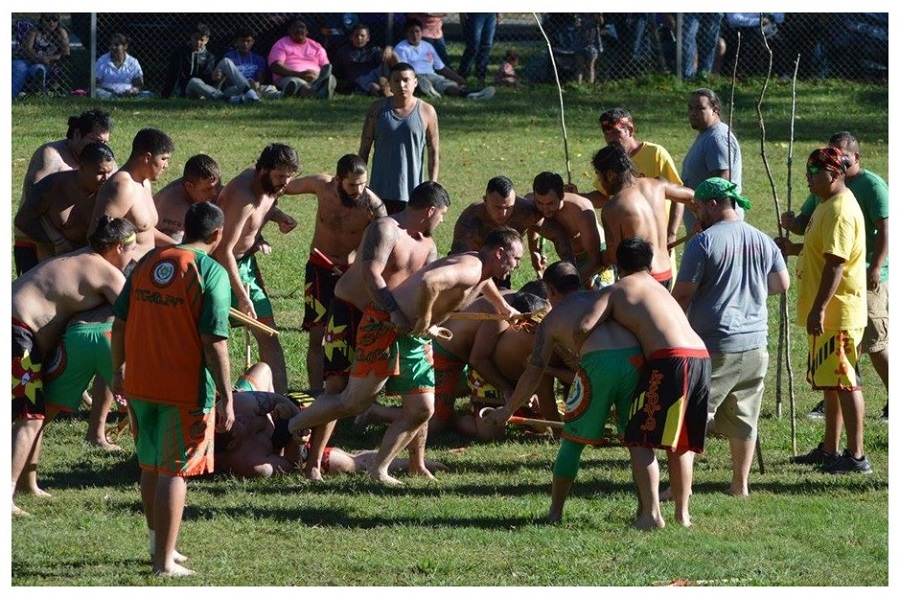 |
Examples
- Little people, boogers- hallucinations or tradition?
- "that's just normal aging"- turnover and unfamiliar relationships in clinics
- Patients going to council members to seek additional assistance for dementia care
Developing the New Road Map for Indian Country
Molly French, MS
Director of Public Health
Alzheimer's Association
Tools?
Take-Aways
- Rising interest
- Solutions from within
- Strengths-based strategies
Healthy Brain Initiative (HBI) Road Maps
- Help public health leaders understand their role
- Offer public health strategies to promote brain health, address dementia, and help support caregivers
Need for 2 Road Maps
- A separate, parallel document for Indian Country that:
- Embraces the unique strengths, priorities, and practices of Indian Country
- Fits with existing health and public health foundations
Building the Road Map
- Input gathered from:
- Regional tribal health boards and members
- Tribal health leaders
- Tribal aging service leaders
- Tribal government officials
- Other experts
Advice & Expertise & Collaboration
- Indian Health Service
- International Association for Indigenous Aging (IA2)
- National Indian Health Board (NIHB)
- Alzheimer's Association
- Centers for Disease Control and Prevention
- Association of State and Territorial Health Officials
- Healthy Brain Research Network
- Administration for Community Living
- Centers for Medicare & Medicaid Services
- National Institute on Aging
- And many more ... Thank You!
Alzheimer's Association & IA2 -- Listening and Learning
- 2 Virtual Listening Sessions
- Tribal Health Directors
- 12 Regions, 500+ invitations
- Tribal Senior Program (Title VI) Directors
- Invitations through Admin. for Comm. Living
- Tribal Health Directors
- 40+ tribal leaders and experts offered written suggestions and comments
Themes
- Knowledge, awareness of dementia varies
- Complex, changing context
- Recommendations
- Involve tribal leadership in planning
- Local leaders know best ways to reach and serve their members
St. Regis Mohawk Nation
- Networking & finding examples
- Community support assist tribal members with dementia and their caregivers
- Alzheimer's Navigator delivers education and coordinate support groups
- Other services: respite care, transportation, caregiver training
Alzheimer's Association & NIHB -- Listening and Learning
- Virtual Input Session on Graphic Design
- Motifs, photos, layout, etc.
- Invited written suggestions and comments
Road Map Intent
- Conversation starter
- Prompt local planning
- Encourage:
- Public health strategies
- Work across and between generations for the good of all
Road Map Strategies
- Educate and empower community members
- Collect and use data
- Strengthen the workforce
Partnering with AI/AN Communities Chapter Innovation Group
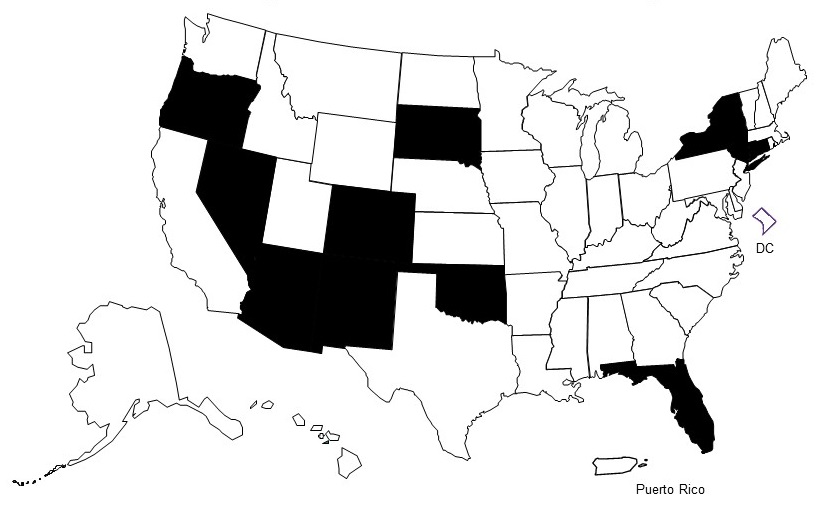 |
Building Our Largest Dementia (BOLD) Infrastructure for Alzheimer's Act (P.L. 115-406)
- Establishes Alzheimer's Centers of Excellence
- Provides funding for state, tribal, and local public health departments across the country
- Increases data analysis and timely reporting
Alzheimer's Association -- Road Map for Indian Country
- Find:
- Road Map for Indian Country
- Tools & examples to help you use it
- Data
- More info about key issues
- https://alz.org/professionals/public-health/road-map/tribal-roadmap
Conclusions
- Rising interest
- Solutions from within
- Strengths-based strategies
Prevalence and Incidence of Dementia in American Indians and Alaska Natives
- "Reliable data on the prevalence or incidence of dementia among populations who identify themselves as American Indian or Alaska Native in the United States are nonexistent."
- "...only a few researchers have attempted to study cognitive status among small samples of American Indian elders, none of which provided prevalence or incidence estimates"
- Mehta and Yeo Epub 2016
Systematic review of dementia prevalence and incidence in United States race/ethnic populations. Mehta KM, Yeo GW. Alzheimers Dement. 2017 Jan; 13(1):72-83. Epub 2016 Sep 4.
Kaiser Permanente Northern CaliforniaDementia Incidence Rates 2000-2013
- KNPC members enrolled and 60 years and older as of 1/1/96
- KNPC seniors (65 years and older) are similar to general population of seniors in Northern CA: hx chronic conditions, lifestyle factors, and patterns of racial inequality (CHIS data)
- No dementia diagnosis as of 1/1/2000
- Incident cases between 1/1/2000 and 12/31/2013.
- Not a population-based study
- Self-identified AI/AN
| Incidence among self-identified American Indians and Alaska Natives is second only to incidence among African-Americans | ||
|---|---|---|
| Race / Ethnicity | Age-adjusted Incidence Rate/1000 person-years (95% CI) | Hazard Ratio |
| African-American | 26.60 (25.83-27.37) | 1.73 - 1.65 |
| American Indian / Alaska Native | 22.18 (20.85-23.52) | 1.32 - 1.43 |
| Latino | 19.59 (18.97-20.20) | 1.24 - 1.29 |
| Pacific Islander | 19.63 (14.51-24.75) | 1.23 - 1.28 |
| White | 19.35 (19.16-19.54) | 1.22 - 1.25 |
| Asian-American | 15.24 (14.73-15.74) | 1.00 (reference) |
Inequalities in dementia incidence between six racial and ethnic groups over 14 years. Alzheimers Dement. 2016 Mar;12(3):216-24.. Epub 2016 Feb 11.
Prevalence of Dementia in First Nations of Alberta 1998-2009
- Aggregate data from Alberta Health and Wellness
- Physician-treated dementia
- Age-adjusted Prevalence
- First Nations: 7.5/1000 (95% CI: 6.6-8.5)
- Non First Nations: 5.6 (95% CI: 5.5-5.6)
- Disproportionately younger and male in First Nations
The emergence of dementia as a health concern among First Nations populations in Alberta, Canada. Jacklin KM, et al. Can J Public Health. 2012 Nov 8;104(1):e39-44.
Trends in Indian Health 2014
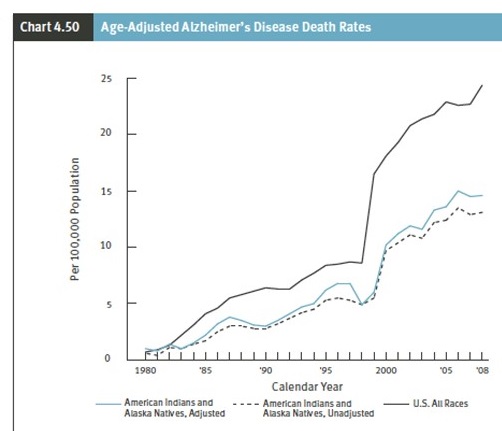 |
| https://www.ihs.gov/dps/publications/trends2014/ |
Population-based risk factors
| Ratio: AI/AN to U.S. All Races | |
|---|---|
| Diabetes | 2.5 |
| Unintentional injury | 2.5 |
| Nephritis, nephrotic syndrome | 1.5 |
| Chronic liver disease and cirrhosis | 4.8 |
| Cerebrovascular Diseases (stroke) | 1.0 |
| Hypertensive disease | 1.0 |
| Alzheimer's disease | 0.7 |
| https://www.ihs.gov/newsroom/factsheets/disparities/ | |
Response to ADRD -- The Indian Health System
NOT COMPREHENSIVE
- Tribal Health Programs and Systems
- Urban Indian Health Programs
- Indian Health Service Direct Services
- Tribal Epidemiology Centers (TECs)
- Regional and National Health Boards and Tribal Organizations
- Native non-profit organizations (e.g. National Indian Council on Aging)
- Non-profit sector health services and consulting organizations
- Private sector health services and consulting organizations
- University-based health services research and programs
- IHS Area Programs
- IHS Headquarters Programs
- CDC -- AI/AN focused staff and programs
- CMS -- Tribal and Intergovernmental Affairs
- SAHMSA -- mental health and substance abuse
- HRSA -- workforce development and Urban Indian Health and Tribal Health Programs (FQHCs and Health Center look-alikes)
- AoA/ACL -- linking to community-based program
ADRD - Focus Areas for IHS
- Awareness in the community
- Timely recognition
- Demand for services
- Community-based services with linkages to health services
- Workforce competency in recognition, diagnosis, management
- Increase knowledge and confidence
- Content includes cultural competencies
- System competence to meet the needs of individuals with dementia.
- Evidence-based caregiver support -- based in REACH
- Targeted care management, integrated into primary care
- Reduction of risk factors for dementia
- Management of DM, HTN, CVD, Substance Use Disorders, Injury Prevention
- Measurement to guide improvement in Care and Services
- NAPA Plan Measurement
- Availability of LTSS
Healthy Brain Initiative -- Strengthening the Public Health Response to Alzheimer's Disease and Dementia
Lisa C. McGUire, PhD
HBI Road Map for Indian Country
- Tailored for tribal health leaders
- Learn, plan, and start responding to Alzheimer's and other dementias
Road Map for Indian Country https://alz.org/professionals/public-health/road-map/tribal-roadmap
Road Map Strategies
- Educate and empower community members
- Collect and use data
- Strengthen the workforce
https://www.cdc.gov/aging/healthybrain/Indian-country-roadmap.html
Educate & Empower Communities
- Educate your community about:
- Brain health
- Talking to a doctor about memory problems
- Increase use of programs and services that support health and wellbeing
- Help families plan for the future
- Encourage your leaders to support public health approaches to dementia
New Materials to Educate & Empower Communities
 |
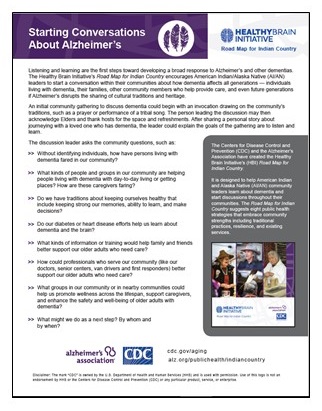 |
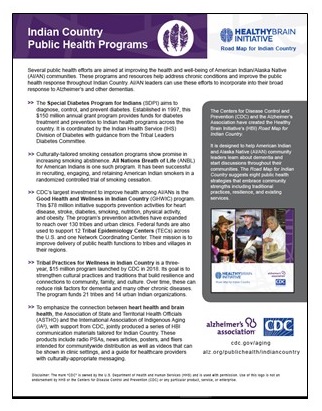 |
Recent CDC Web Feature & DYK
 |
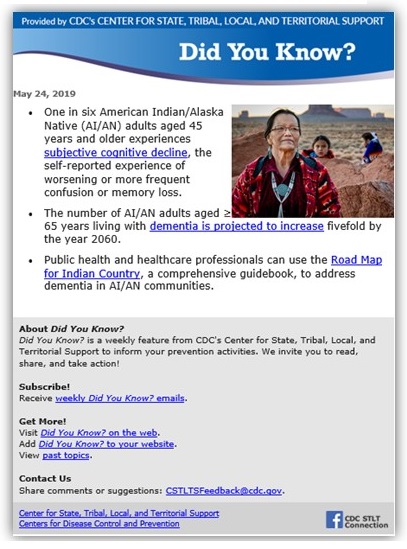 |
| https://www.cdc.gov/aging/publications/features/Alz-Greater-Risk.html | To subscribe https://www.cdc.gov/publichealthgateway/didyouknow/ |
Collect & Use Data
- Get data about how dementia and caregiving affects your community
- Use quality measures to improve care for people living with dementia
Data for Action
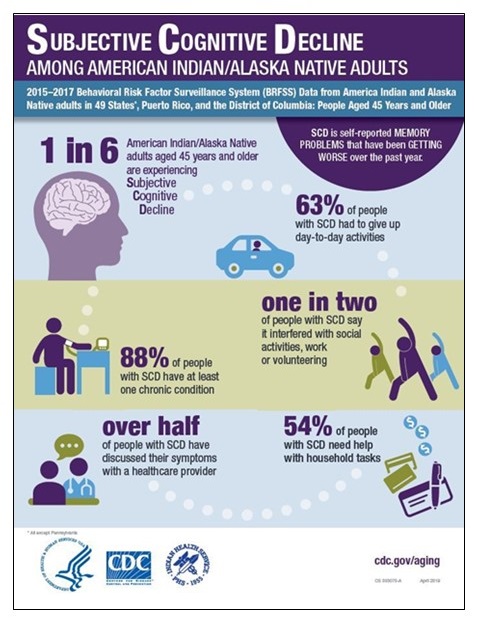 |
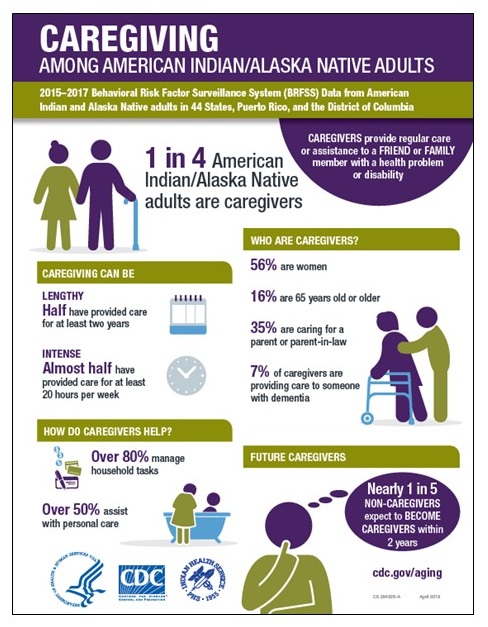 |
| https://www.cdc.gov/aging/data/infographic/2017/american-Indian-alaska-native-cognitive-decline.html | https://www.cdc.gov/aging/data/infographic/2017/american-indian-adults-caregiving.html |
Strengthen the Workforce
- Train people who provide health care or other services about
- Brain health
- Alzheimer's and dementia
- Caregiving
- Give professionals information to share with patients (or clients)
Series of Communication Materials
- Poster and flyers for clinics and health fairs
- Radio public service announcements
- Micro-videos for clinics
- Provider guide about heart and brain health
- Newspaper articles for the Indian Country Today Media Network
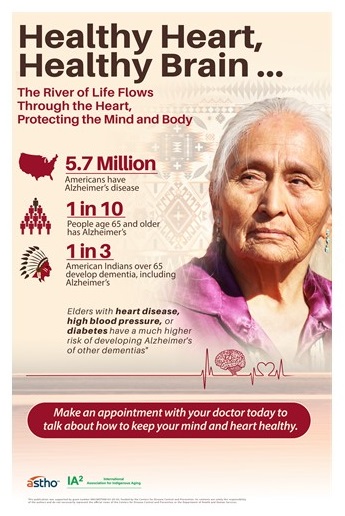 |
| http://www.astho.org/Healthy-Aging/Healthy-Heart-Healthy-Brain/ |
New Continuing Education Course: Brain Health
- Sections:
- Section 1: Descriptions & Risk Fators
- Section 2: Risk Reduction & Management I
- Section 3: Risk Reduction & Management II
- Section 4: Resources & References
- Learning Outcomes:
- Explain-review brain health terminology
- Define and describe risk factors associated with age related cognitive decline, mild cognitive impairment, and dementia
- Summarize lifestyle medicine management strategies, including hypertension management, that may decrease risk
- Continuing Education:
- 1.0 CME/MOC education activity is available through ACPM's learning platform https://www.acpm.org/learn
- Cost:
- Learners can create a free login account and take the course at no cost
https://www.acpm.org/page/brainhealthcourse
New Brain Health Resources
American College of Preventive Medicine
- For your convenience, ACPM provides this collection of resources for physicians, health care professionals, and their patient populations. Materials include those developed by ACPM, its partners, and leading advocates of brain health.
- Research
- Emerging research
- Epidemiological information
- Provider Tools
- Best practices and guidelines
- Screening and diagnostic tools
- Risk factor treatment strategies
- Evidence-based community programs
- Referral strategies
- Insurance coverage
- Provider reimbursement
- Patient Materials
- Patient handouts
Brain Health Resources https://www.acpm.org/page/brainhealth
Additional CDC Public Health Programs and Resources
- Good Health and Wellness in Indian Country
- Tribal Epidemiology Centers
- Tribal Practices for Wellness in Indian Country
- Healthy Heart, Healthy Brain Messaging
Next Steps ... Highlights
- Continue to support States, Territories, and Tribes with data for action and to implement New Road Maps
- Integrate brain health messaging in to chronic disease messaging
- Action Institutes to stimulate strategic changes in policy, systems, and environments
Stay Connected to CDC
 |
| Newsletter Subscription Select "Healthy Aging" https://public.govdelivery.com/accounts/USCDC/subscriber/new?topic_id=USCDC_944 CDC Alzheimer's Diease and Healthy Aging website https://www.cdc.gov/aging/index.html |
Thank you
Dr. Lisa McGuire
lmcguire@cdc.gov
For More Information
Centers for Disease Control and Prevention (CDC)
Alzheimer's Disease and Healthy Aging Program
https://www.cdc.gov/aging/index.html
Alzheimer's Association
Molly French
Public Health Department
mfrench@alz.org
https://alz.org/professionals/public-health/road-map/tribal-roadmap
